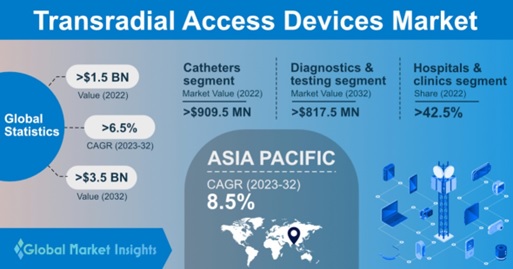Home > Healthcare > Medical Devices > Medical Supplies > Transradial Access Devices Market
Transradial Access Devices Market Size
- Report ID: GMI4987
- Published Date: Jan 2023
- Report Format: PDF
Transradial Access Devices Market Size
Transradial Access Devices Market size was registered at more than USD 1.5 billion in 2022. The industry is slated to grow at over 6.5% CAGR from 2023 to 2032 as a result of the widespread adoption of unhealthy habits, such as alcohol and smoking, along with sedentary lifestyles.
A significant rise in incidences of cardiovascular disease in developed and developing economies is expected to fuel market progress. Moreover, as per the Journal of the American College of Cardiology study, projected rates of cardiovascular risk factors and disease are set to increase substantially in the U.S. by 2060.
Furthermore, the mounting geriatric population base across the globe is also bolstering the demand for TRA devices, thereby augmenting market revenues. Heart-related conditions such as congestive heart failure, coronary artery disease, hypertension, atrial fibrillation, etc. are more common in older adults. According to the Population Reference Bureau, the number of persons aged 65 and above is expected to rise from 52 million in 2018 to almost 95 million by 2060.
| Report Attribute | Details |
|---|---|
| Base Year: | 2022 |
| Transradial Access Devices Market Size in 2022: | USD 1.5 Billion |
| Forecast Period: | 2023 to 2032 |
| Forecast Period 2023 to 2032 CAGR: | 6.5% |
| 2032 Value Projection: | USD 3.5 Billion |
| Historical Data for: | 2018 to 2022 |
| No. of Pages: | 120 |
| Tables, Charts & Figures: | 177 |
| Segments covered: | Product, Application, End-use, and Region |
| Growth Drivers: |
|
| Pitfalls & Challenges: |
|
Stringent regulations may restrain industry progression
A strict regulatory framework is a major factor hampering transradial access devices market revenue. In the U.S., guidelines for peripheral, coronary, and neurovascular devices, including guidewires and catheters, are created by the Centre for Devices and Radiological Health (CDRH). The U.S. FDA rules for patient safety push all medical devices to meet certain criteria. Manufacturers lose time and money if approvals are postponed or rejected. However, supportive initiatives toward healthcare system modification are aiding the market outlook.

